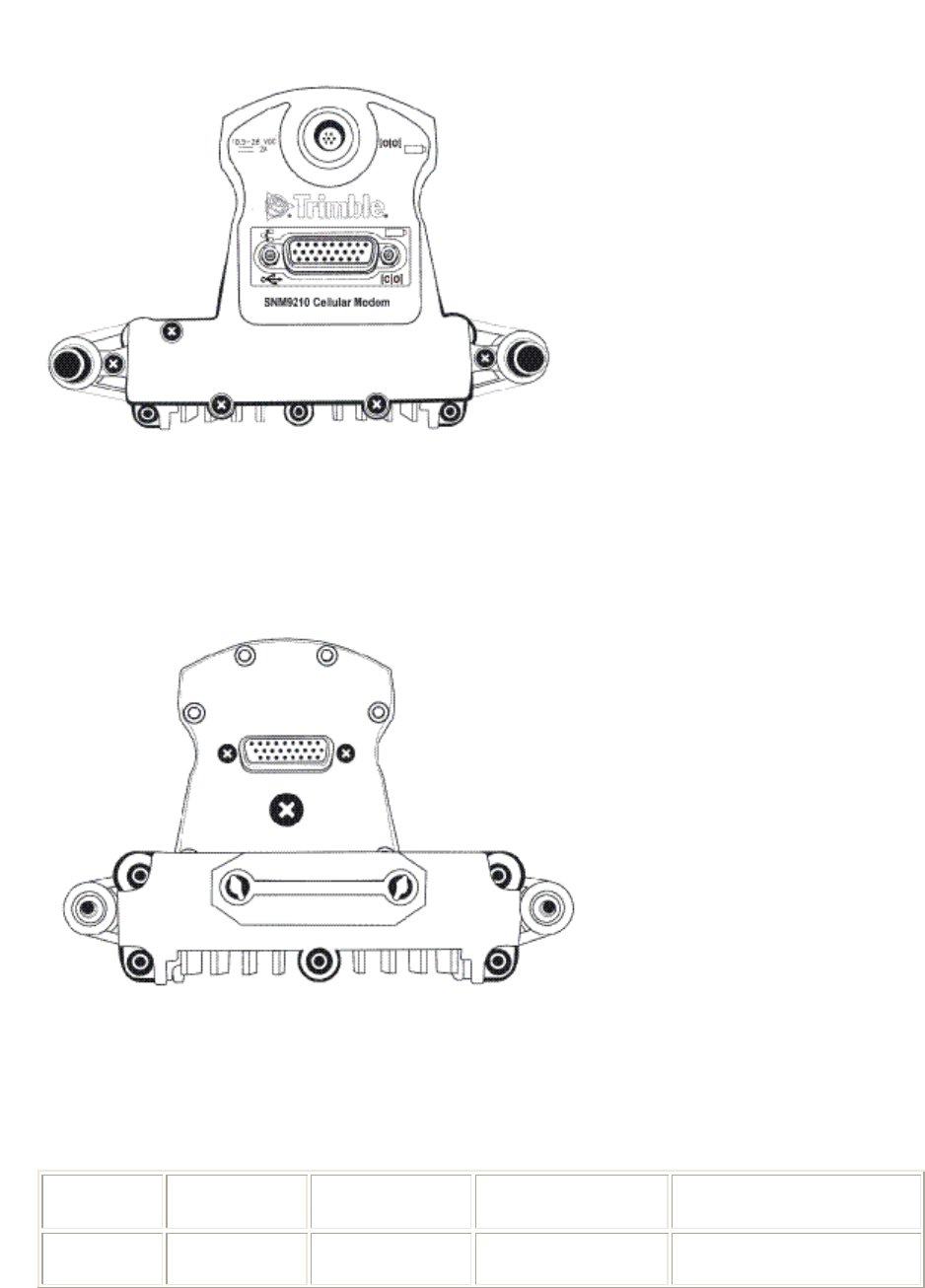Trimble 6999600 GSM/GPRS Modem User Manual
Trimble Navigation Ltd GSM/GPRS Modem Users Manual
Trimble >
Users Manual

SNM910 Site-Net Modem Getting Started
Guide
Draft

1
Trimble SPS Modular GPS
Receivers Help
This Help describes how to use the following products:
• Trimble SPS GPS receivers
This family of receivers comprise the SPSx52 Modular GPS receiver,
the SPSx51 Modular GPS receivers, the SPSx61 Modular Heading GPS
receivers, and the SPS882 Smart GPS antenna.
• SNM910 site-net modem
Where necessary, this Help contains references to specific receivers in the
product family. When information is specific to a particular model, then the
specific model name is used.
Even if you have used other Global Positioning System (GPS) products before,
Trimble recommends that you spend some time reading this manual to learn
about the special features of this product. If you are not familiar with GPS,
visit the Trimble website (www.trimble.com) for an interactive look at Trimble
and GPS.

3
Legal Notices
Corporate Office
Trimble Navigation Limited
935 Stewart Drive
Sunnyvale, CA 94085
USA
www.trimble.com
Heavy Highway business area
Trimble Navigation Limited
Heavy Highway business area
5475 Kellenburger Road
Dayton, Ohio 45424-1099
USA
800-538-7800 (toll free in USA)
+1-937-245-5600 Phone
+1-937-233-9004 Fax
www.trimble.com
E-mail: trimble_support@trimble.com
Legal Notices
© 2006–2009, Trimble Navigation Limited. All rights reserved.
Trimble, and the Globe & Triangle logo are trademarks of Trimble Navigation Limited,
registered in the United States Patent and Trademark Office and in other countries.
AutoBase, CMR, CMR+, CMRx, HYDROpro, Maxwell, Micro-Centered, TGO, SiteNet,
TRIMMARK, TRIMTALK, TSC2, TSCe, VRS, Zephyr, and Zephyr Geodetic are
trademarks of Trimble Navigation Limited.
The Bluetooth word mark and logos are owned by the Bluetooth SIG, Inc. and any use
of such marks by Trimble Navigation Limited is under license. Microsoft, Windows, and
Windows NT are either registered trademarks or trademarks of Microsoft Corporation
in the United States and/or other countries.All other trademarks are the property of
their respective owners.
Release Notice
This is the October 2009 release (Revision A) of the SPS Receivers Help. It applies to
version 4.00 of the receiver firmware.
Product Limited Warranty Information
For applicable product Limited Warranty information, please refer to the Limited
Warranty Card included with this Trimble product, or consult your local Trimble
authorized dealer.

SNM910 Site-Net Modem Getting Started Guide
4
COCOM limits
The U.S. Department of Commerce requires that all exportable GPS products
contain performance limitations so that they cannot be used in a manner that
could threaten the security of the United States. The following limitations are
implemented on this product:
• Immediate access to satellite measurements and navigation results
is disabled when the receiver velocity is computed to be greater than
1,000 knots, or its altitude is computed to be above 18,000 meters.
The receiver GPS subsystem resets until the COCOM situation clears.
As a result, all logging and stream configurations stop until the GPS
subsystem is cleared.
Notices
Class B Statement – Notice to Users. This equipment has been tested and found to
comply with the limits for a Class B digital device, pursuant to Part 15 of the FCC rules
and Part 90. These limits are designed to provide reasonable protection against
harmful interference in a residential installation. This equipment generates, uses, and
can radiate radio frequency energy and, if not installed and used in accordance with
the instructions, may cause harmful interference to radio communication. However,
there is no guarantee that interference will not occur in a particular installation. If this
equipment does cause harmful interference to radio or television reception, which can
be determined by turning the equipment off and on, the user is encouraged to try to
correct the interference by one or more of the following measures:
• Reorient or relocate the receiving antenna.
• Increase the separation between the equipment and the receiver.
• Connect the equipment into an outlet on a circuit different from that to which
the receiver is connected.
• Consult the dealer or an experienced radio/TV technician for help.
Changes and modifications not expressly approved by the manufacturer or registrant
of this equipment can void your authority to operate this equipment under Federal
Communications Commission rules.
Canada
This Class B digital apparatus complies with Canadian ICES-003.
Cet appareil numérique de la classe B est conforme à la norme NMB-003 du Canada.
This apparatus complies with Canadian RSS-GEN, RSS-310, RSS-210, and RSS-119.
Cet appareil est conforme à la norme CNR-GEN, CNR-310, CNR-210, et CNR-119 du
Canada.
Europe

Legal Notices
5
The product covered by this guide are intended to be used in all EU member countries,
Norway, and Switzerland. Products been tested and found to comply with the
requirements for a Class B device pursuant to European Council Directive 89/336/EEC
on EMC, thereby satisfying the requirements for CE Marking and sale within the
European Economic Area (EEA). Contains a Bluetooth radio module. These
requirements are designed to provide reasonable protection against harmful
interference when the equipment is operated in a residential or commercial
environment. The 450 MHZ (PMR) bands and 2.4 GHz are non-harmonized throughout
Europe.
CE Declaration of Conformity
Hereby, Trimble Navigation, declares that the GPS receivers are in compliance with the
essential requirements and other relevant provisions of Directive 1999/5/EC.
Australia and New Zealand
This product conforms with the regulatory requirements of the Australian
Communications and Media Authority (ACMA) EMC framework, thus satisfying the
requirements for C-Tick Marking and sale within Australia and New Zealand.
Taiwan – Battery Recycling Requirements
(SPSx51 and SPS882 only)
The product contains a removable Lithium-ion battery. Taiwanese regulations require
that waste batteries are recycled.
廢電池請回收
Restriction of Use of Certain Hazardous Substances in Electrical and
Electronic Equipment (RoHS)
Trimble products in this guide comply in all material respects with DIRECTIVE
2002/95/EC OF THE EUROPEAN PARLIAMENT AND OF THE COUNCIL of 27 January
2003 on the restriction of the use of certain hazardous substances in electrical and
electronic equipment (RoHS Directive) and Amendment 2005/618/EC filed under
C(2005) 3143, with exemptions for lead in solder pursuant to Paragraph 7 of the
Annex to the RoHS Directive applied.
Waste Electrical and Electronic Equipment (WEEE)
For product recycling instructions and more information, please go to
www.trimble.com/ev.shtml.

SNM910 Site-Net Modem Getting Started Guide
6
Recycling in Europe: To recycle Trimble WEEE (Waste Electrical and Electronic
Equipment, products that run on electrical power.), Call +31 497 53 24 30, and ask for
the “WEEE Associate”. Or, mail a request for recycling instructions to:
Trimble Europe BV
c/o Menlo Worldwide Logistics
Meerheide 45
5521 DZ Eersel, NL
FCC Declaration of Conformity
We, Trimble Navigation Limited.
935 Stewart Drive
PO Box 3642
Sunnyvale, CA 94088-3642
United States
+1-408-481-8000
Declare under sole responsibility that DoC products comply with
Part 15 of FCC Rules.
Operation is subject to the following two conditions:
(1) This device may not cause harmful interference, and
(2) This device must accept any interference received, including
interference that may cause undesired operaton
Unlicensed radios in Products
This device complies with part 15 of the FCC Rules.
Operation is subject to the following two conditions:
(1) This device may not cause harmful interference, and
(2) This device must accept any interference received, including interference that may
cause undesired operaton.
Licensed radios in Products
This device complies with part 15 of the FCC Rules.
Operation is subject to the condition that this device may not cause harmful
interference.

7
Introduction
Related information
Sources of related information include the following:
• Release notes – The release notes describe new features of the
product, information not included in the manuals, and any changes to
the manuals. They can be downloaded from the Trimble website
(www.trimble.com/support.shtml).
• Trimble training courses – Consider a training course to help you
use your GPS system to its fullest potential. For more information, go to
the Trimble website at www.trimble.com/training.html.
Technical support
If you have a problem and cannot find the information you need in the product
documentation, contact your local dealer. Alternatively, go to the Support area
of the Trimble website (www.trimble.com/support.shtml). Select the product
you need information on. Product updates, documentation, and any support
issues are available for download.
If you need to contact Trimble technical support, complete the online inquiry
form at www.trimble.com/support_form.asp.
Your comments
Your feedback about the supporting documentation helps us to improve it with
each revision. Email your comments to ReaderFeedback@trimble.com.

9
Getting Started Guides
SNM910 Site-Net Modem
Safety Information
Before you use your Trimble product, make sure that you have read and
understood all safety requirements.
Use and care
This product is designed to withstand the rough treatment and tough
environment that typically occurs in construction applications. However, the
receiver is a high-precision electronic instrument and should be treated with
reasonable care.
Caution – Operating or storing the receiver outside the specified temperature
range can damage it.
Regulations and safety
Some SPS receiver models with Base capability contain an internal radio-
modem for transmission or can transmit through an external data
communications radio. Regulations regarding the use of the 410-470 MHz
radio-modems vary greatly from country to country. In some countries, the
unit can be used without obtaining an end-user license. Other countries require
end-user licensing. For licensing information, consult your local Trimble dealer.
All SPS receiver models are capable of transmitting data via Bluetooth.
Bluetooth, and 900 MHz1 , (and 2.4 GHz radio-modems - Japan only) operate
in license-free bands.
The SNM910 contains an internal Quad-Band GSM 850/900/1800/1900MHz
radio Modem.
Before operating a Trimble GPS receiver or GSM modem, determine if
authorization or a license to operate the unit is required in your country. It is
the responsibility of the end user to obtain an operator's permit or license for
the receiver for the location or country of use.
For FCC regulations, see Legal Notices.
Type approval
Type approval, or acceptance, covers technical parameters of the equipment
related to emissions that can cause interference. Type approval is granted to
the manufacturer of the transmission equipment, independent from the
operation or licensing of the units. Some countries have unique technical
requirements for operation in particular radio-modem frequency bands. To
comply with those requirements, Trimble may have modified your equipment
to be granted Type approval.

SNM910 Site-Net Modem Getting Started Guide
10
Unauthorized modification of the units voids the Type approval, the warranty,
and the operational license of the equipment.
Exposure to radio frequency radiation
For 450 MHz radio
Safety. Exposure to RF energy is an important safety consideration. The FCC
has adopted a safety standard for human exposure to radio frequency
electromagnetic energy emitted by FCC regulated equipment as a result of its
actions in General Docket 79-144 on March 13, 1986.
Proper use of this radio modem results in exposure below government limits.
The following precautions are recommended:
• DO NOT operate the transmitter when someone is within 20
cm (7.8 inches) of the antenna.
• DO NOT operate the transmitter unless all RF connectors are
secure and any open connectors are properly terminated.
• DO NOT operate the equipment near electrical blasting caps
or in an explosive atmosphere.
• All equipment must be properly grounded according to
Trimble installation instructions for safe operation.
• All equipment should be serviced only by a qualified
technician.
For license-free 900 MHz radio1
Caution – For your own safety, and in terms of the RF exposure
requirements of the FCC, always observe the precautions listed here.
• DO NOT operate the transmitter when someone is within 20
cm (7.8 inches) of the antenna.
• Do not co-locate the antenna with any other transmitting
device.
For 2.4 GHz radio2
Safety. Exposure to RF energy is an important safety consideration. The FCC
has adopted a safety standard for human exposure to radio frequency
electromagnetic energy emitted by FCC regulated equipment as a result of its
actions in General Docket 79-144 on March 13, 1986.
Proper use of this radio modem results in exposure below government limits.
The following precautions are recommended:
• DO NOT operate the transmitter when someone is within 20
cm (7.8 inches) of the antenna.
The maximum gain of the antenna must not exceed 8 dBi.

Getting Started Guides
11
For Bluetooth radio
The radiated output power of the internal Bluetooth wireless radio is far below
the FCC radio frequency exposure limits. Nevertheless, the wireless radio shall
be used in such a manner that the Trimble receiver is 20 cm or further from
the human body. The internal wireless radio operates within guidelines found
in radio frequency safety standards and recommendations, which reflect the
consensus of the scientific community. Trimble therefore believes that the
internal wireless radio is safe for use by consumers. The level of energy
emitted is far less than the electromagnetic energy emitted by wireless devices
such as mobile phones. However, the use of wireless radios may be restricted
in some situations or environments, such as on aircraft. If you are unsure of
restrictions, you are encouraged to ask for authorization before turning on the
wireless radio.
For GSM/GPRS radio
Safety. Exposure to RF energy is an important safety consideration. The FCC
has adopted a safety standard for human exposure to radio frequency
electromagnetic energy emitted by FCC regulated equipment as a result of its
actions in General Docket 79-144 on March 13, 1986.
Proper use of this radio modem results in exposure below government limits.
The following precautions are recommended:
• DO NOT operate the transmitter when someone is within 28
cm (11 inches) of the antenna.
• All equipment should be serviced only by a qualified
technician.
Installing antennas
Caution –For your own safety, and in terms of the RF exposure
requirements of the FCC, always observe these precautions:
– Always maintain a minimum separation distance of 20 cm (7.8
inches) between yourself and the radiating antenna.
– Do not co-locate the antenna with any other transmitting device.
Caution – The GPS antenna and its cabling should be installed in
accordance with all national and local electrical codes, regulations,
and practices.
The antenna and cabling should be installed where they will not
become energized as a result of falling nearby power lines, nor be
mounted where they are subjected to overvoltage transients,
particularly lightning. Such installations require additional protective
means that are detailed in national and local electrical codes.
Trimble SPS internal radios have been designed to operate with the antennas
listed below. Antennas not included in this list are strictly prohibited for use
with this device. The required antenna impedance is 50 ohms.

SNM910 Site-Net Modem Getting Started Guide
12
The antennas that can be used (country dependent) with the 450 MHz radio
are 0 dBi and 5 dBi whip antennas. The antennas that can be used (country
dependent) with the 900 MHz radio are 0 dBi, 3 dBi, and 5 dBi whip antennas.
The antennas that can be used (country dependant) with the2.4 GHz radio
are 2 dBi and 8 dBi whip antennas.
To reduce potential radio interference to other users, the antenna type and its
gain should be so chosen so that the equivalent isotropically radiated power
(e.i.r.p.) is not more than that permitted for successful communication.
Battery safety
SPS receiver internal lithium-ion battery
WARNING – Do not damage the rechargeable Lithium-ion battery. A
damaged battery can cause an explosion or fire, and can result in personal
injury and/or property damage.
To prevent injury or damage:
– Do not use or charge the battery if it appears to be damaged. Signs of
damage include, but are not limited to, discoloration, warping, and leaking
battery fluid.
– Do not expose the battery to fire, high temperature, or direct sunlight.
– Do not immerse the battery in water.
– Do not use or store the battery inside a vehicle during hot weather.
– Do not drop or puncture the battery.
– Do not open the battery or short-circuit its contacts.
WARNING - Avoid contact with the rechargeable Lithium-ion battery if it
appears to be leaking. Battery fluid is corrosive, and contact with it can
result in personal injury and/or property damage.
To prevent injury or damage:
– If the battery leaks, avoid contact with the battery fluid.
– If battery fluid gets into your eyes, immediately rinse your eyes with
clean water and seek medical attention. Do not rub your eyes!
– If battery fluid gets onto your skin or clothing, immediately use clean
water to wash off the battery fluid.
WARNING - Charge and use the rechargeable Lithium-ion battery only in
strict accordance with the instructions. Charging or using the battery in
unauthorized equipment can cause an explosion or fire, and can result in
personal injury and/or equipment damage. To prevent injury or damage:
– Do not charge or use the battery if it appears to be damaged or leaking.
– Charge the Lithium-ion battery only in a Trimble product that is specified
to charge it. Be sure to follow all instructions that are provided with the
battery charger.
– Discontinue charging a battery that gives off extreme heat or a burning
odor.
– Use the battery only in Trimble equipment that is specified to use it.
– Use the battery only for its intended use and according to the
instructions in the product documentation.
Connecting SPS receivers to a vehicle battery

Getting Started Guides
13
WARNING – Use caution when connecting battery cable's clip leads to a
vehicle battery. Do not allow any metal object or jewelry to connect (short)
the battery's positive (+) terminal to either the negative (-) terminal or the
metal of the vehicle connected to the battery. This could result in high
current, arcing, and high temperatures, exposing the user to possible
injury.
WARNING - When connecting an external battery, such as a vehicle
battery, to an SPS receiver, be sure to use the Trimble cable with proper
over-current protection intended for this purpose, to avoid a safety hazard
to the user or damage to the product.
Changing the Radio module
SPS882 only
Trimble requires that you do not change from one version of a radio door
assembly to another, for the following reasons:
• The regulatory compliance requirements will be violated.
Operating such a product is illegal.
• The internal connector on the radio is not intended for
multiple insertions or extractions. It may be damaged or break if
overused.
• The seal integrity of the whole GPS receiver is compromised
when the radio is removed. Users do not have the facilities to test
the integrity of the seal.
• If the unit is outside of warranty, you can purchase another
radio door, which must be installed by a Trimble authorized
Service Provider. There are hardware limitations to this, so be
very careful, especially with the 900 MHz doors.
Caution - Because of installation problems and country regulation
issues, Trimble does not sell radio doors to end users. Trimble
authorized Service Providers must comply with country regulations
and install the correct radio only in defined and accepted receivers.
Installing a radio in a non-specified GPS product or device voids any
warranty of the radio and of the GPS product. It also subjects the
service provider to penalties set forth by various government
agencies. Trimble shall assume no liability for radios used in non-
authorized products.
Wet locations
SPSx61 only
WARNING - This product is not intended to be used outdoors or in a wet location
when it is powered by the Power over Ethernet (POE) interface, or by the external
power supply.

SNM910 Site-Net Modem Getting Started Guide
14
WARNING - The external power adaptor and its associated power cord and plug are
not intended to be installed outdoors, or in a wet location.
Use of Power over Ehternet
SPSx61 only
WARNING - When this product is connected to a Power over Ethernet connection,
the source of the Ethernet power must meet IEEE 802.11af, and its DC output
(Ethernet power source) must be completely isolated from earth ground (floating),
or a shock hazard may exist.
WARNING - The external power adaptor and its associated power cord and plug are
not intended to be installed outdoors, or in a wet location.
1. 900 MHz radios are not used in Europe.
2. 2.40 GHz radios are available initially only for Japan.
SNM910 Site-Net Modem: What's in the box
list of items.
Item
Part Number
SNM910 Site-Net Modem: Setting up a SIM card and IP address
Types of SIM cards
<which ones are suitable>
Obtaining a SIM card
How does a user get a card?
IP addresses
Getting Started Guides
15
<Dynamic or static, public or private - which IP address type is required>
Trimble server?? as a solution
SNM910 Site-Net Modem: Connecting and turning on
Mounting brackets
Before the SNM910 modem can be installed, the correct mounting bracket
must be attached to the host device:
1. Remove the rubber end bumpers from the host device to
expose the two pairs of fixing holes on the underside of the host
end caps.
2. Attach the mounting bracket using the four screws that are
provided.
3. Replace the rubber end bumpers.
SIM card
Insert the SIM card into the SNM910 modem before attaching it to the host
device:
1. Remove the SIM slot cover by unscrewing the two screws.
2. Insert the SIM card with orientation as shown on the SNM910
casing.
3. Push the SIM card into the slot until it locks in place (i.e., it
does not spring back when released).
4. Replace the SIM slot cover and tighten the two screws.
Attaching the SNM910 site-net modem to the host device
After the bracket has been attached and the SIM card installed, attach the
SNM910 site-net modem to the host device:
1. Turn off the power on the host device.
2. Slide the SNM910 site-net modem into the supporting
bracket and ensure that the 26-pin connector mates correctly
with the host device.
3. Tighten the two thumb screws.
4. Connect an external power cable to the SNM910 site-net
modem.
5. Turn on the host device.

SNM910 Site-Net Modem Getting Started Guide
16
Rear view
Front view
Cables
Part
Number SNM910
connection Power
connection Power Source Other connectors
46125-20 7-pin Lemo 'Croc' clips Power from 12 V
car battery None

Getting Started Guides
17
59044 7-pin Lemo Cable with DC
plug
Power from 12 V
car battery Serial
67384 7-pin Lemo Cable with DC
plug
Power to host
devices from AC
adapter
Serial-to-serial for
Moving Base applications
57167 26-pin Adapter with
DC plug
Power from AC
adapter
USB(B) socket and
Ethernet socket
57168 26-pin Adapter with
DC plug
Power from AC
adapter
Serial and Ethernet
socket
77070-00 26-pin Cable with DC
plug
Power from AC
adapter
2 x Serial, Ethernet
plug, USB(A) plug, 1PPS
(BNC)
78235-00 26-pin Cable with DC
plug
Power from AC
adapter
2 x Serial, Ethernet
socket
Using the SNM910 Site-Net Modem with the SPS Receivers
Using the SNM910 Site-Net Modem with the SPS Receivers
In this section:
• Web interface
• Front panel <<link yet to be done>>
• Setting up an iBase
• Setting up an SPS rover receiver
Configuring the SNM910 site-net modem for use with SPS receivers
SPSx61 and SPSx51 only
How to connect to host using a web browser.
Which web browsers are supported.
Description of web UI pages which are releavant to the SNM910:
• GPRS modem
• Network
SNM910 Site-Net Modem Getting Started Guide
18
• PPP
• I/O
Note –
Heading
Setting up a SNM910 site-net modem for use with a SPS rover receiver
SPSx61 and SPSx51 only
Photo of typical rover with an SNM910 on a marine vessel
step-by-step instructions
Note –
Heading
Connecting a SNM910 site-net modem to an SPS receiver using the Web interface
SPSx61 and SPSx51 only
How to connect to host using a web browser.
Which web browsers are supported.
Description of web UI pages which are releavant to the SNM910:
• GPRS modem
• Network
• PPP
• I/O
Note –
Heading
Using the SNM910 Site-Net Modem with the SNB900R Radio Modem
Use cases for a SNM910 site-net modem
Detail some use cases (line art of long road job with SNM910/SNB900 used for
CMR rebroadcast)
Note –
Getting Started Guides
19
Heading
SNB900 front panel
Description of front panel on host SNB900 that relate to the SNM910
Note –
Heading
Setting up a 900 MHz rebroadcaster
<photo of SNM910/SNB900 using AC supply in office>
<photo of SNM910/SNB900 using DC supply in field>
Mounting options - Tripod, benchtop, lighting pole
Step-by-step instructions
Note –
Heading
Getting the best performance
Choosing the best location for radio and cellular.
Note –
Heading
Connecting a SNM910 site-net modem to an SNB900 radio-modem using the Web
interface
How to connect to host using a web browser.
Which web browsers are supported.
Description of web UI pages which are releavant to the SNM910:
SNM910 Site-Net Modem Getting Started Guide
20
• GPRS modem
• Network
• PPP
• I/O
Note –
Heading

21
Glossary
1PPS Pulse-per-second. Used in hardware timing. A pulse is
generated in conjunction with a time stamp. This defines
the instant when the time stamp is applicable.
almanac
A file that contains orbit information on all the satellites,
clock corrections, and atmospheric delay parameters. The
almanac is transmitted by a GPS satellite to a GPS
receiver, where it facilitates rapid acquisition of GPS
signals when you start collecting data, or when you have
lost track of satellites and are trying to regain GPS
signals.
The orbit information is a subset of the
emphemeris/ephemerides data.
AutoBase
AutoBase technology uses the position of the receiver to
automatically select the correct base station; allowing for
one button press operation of a base station. It shortens
setup time associated with repeated daily base station
setups at the same location on jobsites.
base station
Also called reference station. A base station in
construction, is a receiver placed at a known point on a
jobsite that tracks the same satellites as an RTK rover,
and provides a real-time differential correction message
stream through radio to the rover, to obtain centimeter
level positions on a continuous real-time basis. A base
station can also be a part of a virtual reference station
network, or a location at which GPS observations are
collected over a period of time, for subsequent
postprocessing to obtain the most accurate position for
the location.
beacon Source of RTCM DGPS corrections transmitted from
coastal reference stations in the 283.5 to 325.0 kHz
range.
BINEX
BInary EXchange format. BINEX is an operational binary
format standard for GPS/GLONASS/SBAS research
purposes. It has been designed to grow and allow
encapsulation of all (or most) of the information currently
allowed for in a range of other formats.
broadcast server
An Internet server that manages authentication and
password control for a network of VRS servers, and
relays VRS corrections from the VRS server that you
select.
carrier A radio wave having at least one characteristic (such as
frequency, amplitude, or phase) that can be varied from
a known reference value by modulation.
carrier frequency
The frequency of the unmodulated fundamental output of
a radio transmitter. The GPS L1 carrier frequency is
1575.42 MHz.

SNM910 Site-Net Modem Getting Started Guide
22
carrier phase Is the cumulative phase count of the GPS or GLONASS
carrier signal at a given time.
cellular modems
A wireless adaptor that connects a laptop computer to a
cellular phone system for data transfer. Cellular modems,
which contain their own antennas, plug into a PC Card
slot or into the USB port of the computer and are
available for a variety of wireless data services such as
GPRS.
CMR/CMR+
Compact Measurement Record. A real-time message
format developed by Trimble for broadcasting corrections
to other Trimble receivers. CMR is a more efficient
alternative to RTCM.
CMRx
A real-time message format developed by Trimble for
transmitting more statellite corrections resulting from
more satellite signals, more constellations, and more
satellites. Its compactness means more repeaters can be
used on a site.
covariance
A statistical measure of the variance of two random
variables that are observed or measured in the same
mean time period. This measure is equal to the product
of the deviations of corresponding values of the two
variables from their respective means.
datum
Also called geodetic datum. A mathematical model
designed to best fit the geoid, defined by the relationship
between an ellipsoid and, a point on the topographic
surface, established as the origin of the datum. World
geodetic datums are typically defined by the size and
shape of an ellipsoid and the relationship between the
center of the ellipsoid and the center of the earth.
Because the earth is not a perfect ellipsoid, any single
datum will provide a better model in some locations than
in others. Therefore, various datums have been
established to suit particular regions.
For example, maps in Europe are often based on the
European datum of 1950 (ED-50). Maps in the United
States are often based on the North American datum of
1927 (NAD-27) or 1983 (NAD-83).
All GPS coordinates are based on the WGS-84 datum
surface.
deep discharge Withdrawal of all electrical energy to the end-point
voltage before the cell or battery is recharged.
DGPS See real-time differential GPS.
differential correction
Differential correction is the process of correcting GPS
data collected on a rover with data collected
simultaneously at a base station. Because the base
station is on a known location, any errors in data
collected at the base station can be measured, and the
necessary corrections applied to the rover data.
Differential correction can be done in real-time, or after

Glossary
23
the data has been collected by postprocessing.
differential GPS See real-time differential GPS.
DOP
Dilution of Precision. A measure of the quality of GPS
positions, based on the geometry of the satellites used to
compute the positions. When satellites are widely spaced
relative to each other, the DOP value is lower, and
position accuracy is greater. When satellites are close
together in the sky, the DOP is higher and GPS positions
may contain a greater level of error.
PDOP (Position DOP) indicates the three-dimensional
geometry of the satellites. Other DOP values include
HDOP (Horizontal DOP) and VDOP (Vertical DOP), which
indicate the accuracy of horizontal measurements
(latitude and longitude) and vertical measurements
respectively. PDOP is related to HDOP and VDOP as
follows: PDOP² = HDOP² + VDOP².
dual-frequency GPS
A type of receiver that uses both L1 and L2 signals from
GPS satellites. A dual-frequency receiver can compute
more precise position fixes over longer distances and
under more adverse conditions because it compensates
for ionospheric delays.
EGNOS
European Geostationary Navigation Overlay Service. A
satellite-based augmentation system (SBAS) that
provides a free-to-air differential correction service for
GPS. EGNOS is the European equivalent of WAAS, which
is available in the United States.
elevation mask
The angle below which the receiver will not track
satellites. Normally set to 10 degrees to avoid
interference problems caused by buildings and trees,
atmospheric issues, and multipath errors.
ellipsoid
An ellipsoid is the three-dimensional shape that is used
as the basis for mathematically modeling the earth’s
surface. The ellipsoid is defined by the lengths of the
minor and major axes. The earth’s minor axis is the polar
axis and the major axis is the equatorial axis.
emphemeris/ephemerides
A list of predicted (accurate) positions or locations of
satellites as a function of time. A set of numerical
parameters that can be used to determine a satellite’s
position. Available as broadcast ephemeris or as
postprocessed precise ephemeris.
epoch
The measurement interval of a GPS receiver. The epoch
varies according to the measurement type: for real-time
measurement it is set at one second; for postprocessed
measurement it can be set to a rate of between one
second and one minute. For example, if data is measured
every 15 seconds, loading data using 30-second epochs
means loading every alternate measurement.
feature A feature is a physical object or event that has a location
in the real world, which you want to collect position
and/or descriptive information (attributes) about.

SNM910 Site-Net Modem Getting Started Guide
24
Features can be classified as surface or non-surface
features, and again as points, lines/breaklines, or
boundaries/areas.
firmware The program inside the receiver that controls receiver
operations and hardware.
GLONASS
Global Orbiting Navigation Satellite System. GLONASS is
a Soviet space-based navigation system comparable to
the American GPS system. The operational system
consists of 21 operational and 3 non-operational satellites
in 3 orbit planes.
GNSS Global Navigation Satellite System.
GSOF General Serial Output Format. A Trimble proprietary
message format.
HDOP Horizontal Dilution of Precision. HDOP is a DOP value that
indicates the accuracy of horizontal measurements. Other
DOP values include VDOP (vertical DOP) and PDOP
(Position DOP).
Using a maximum HDOP is ideal for situations where
vertical precision is not particularly important, and your
position yield would be decreased by the vertical
component of the PDOP (for example, if you are
collecting data under canopy).
L1 The primary L-band carrier used by GPS and GLONASS
satellites to transmit satellite data.
L2 The secondary L-band carrier used by GPS and GLONASS
satellites to transmit satellite data.
L2C A modernized code that allows significantly better ability
to track the L2 frequency.
L5
The third L-band carrier used by GPS satellites to
transmit satellite data. L5 will provide a higher power
level than the other carriers. As a result, acquiring and
tracking weak signals will be easier.
Location RTK
Some applications such as vehicular-mounted site
supervisor systems do not require Precison RTK accuracy.
Location RTK is a mode in which, once initialized, the
receiver will operate either in 10 cm horizontal and 10 cm
vertical accuracy, or in 10 cm horizontal and and 2 cm
vertical accuracy.
Mountpoint
Every single NTripSource needs a unique mountpoint on
an NTripCaster. Before transmitting GNSS data to the
NTripCaster, the NTripServer sends an assignment of the
mountpoint.
Moving Base
Moving Base is an RTK positioning technique in which
both reference and rover receivers are mobile.
Corrections are sent from a “base” receiver to a “rover”
receiver and the resultant baseline (vector) has
centimeter-level accuracy.

Glossary
25
MSAS
MTSAT Satellite-Based Augmentation System. A satellite-
based augmentation system (SBAS) that provides a free-
to-air differential correction service for GPS. MSAS is the
Japanese equivalent of WAAS, which is available in the
United States.
multipath
Interference, similar to ghosts on an analog television
screen, that occurs when GPS signals arrive at an
antenna having traversed different paths. The signal
traversing the longer path yields a larger pseudorange
estimate and increases the error. Multiple paths can arise
from reflections off the ground or off structures near the
antenna.
NMEA
National Marine Electronics Association. NMEA 0183
defines the standard for interfacing marine electronic
navigational devices. This standard defines a number of
'strings' referred to as NMEA strings that contain
navigational details such as positions. Most Trimble GPS
receivers can output positions as NMEA strings.
NTrip Protocol
Networked Transport of RTCM via Internet Protocol
(NTrip) is an application-level protocol that supports
streaming Global Navigation Satellite System (GNSS) data
over the Internet. NTrip is a generic, stateless protocol based
on the Hypertext Transfer Protocol (HTTP). The HTTP
objects are extended to GNSS data streams.
NTripCaster
The NTripCaster is basically an HTTP server supporting a
subset of HTTP request/response messages and adjusted
to low-bandwidth streaming data. The NTripCaster
accepts request messages on a single port from either
the NTripServer or the NTripClient. Depending on these
messages, the NTripCaster decides whether there is
streaming data to receive or to send.
Trimble NTripCaster integrates the NTripServer and the
NTripCaster. This port is used only to accept requests
from NTripClients.
NTripClient
An NTripClient will be accepted by and receive data from
an NTripCaster, if the NTripClient sends the correct
request message (TCP/UDP connection to the specified
NTripCaster IP and listening port).
NTripServer
The NTripServer is used to transfer GNSS data of an
NTripSource to the NTripCaster. An NTripServer in its
simplest setup is a computer program running on a PC
that sends correction data of an NTripSource (for
example, as received through the serial communication
port from a GNSS receiver) to the NTripCaster.
The NTripServer - NTripCaster communication extends
HTTP by additional message formats and status codes.
NTripSource
The NTripSources provide continuous GNSS data (for
example, RTCM-104 corrections) as streaming data. A
single source represents GNSS data referring to a specific
location. Source description parameters are compiled in

SNM910 Site-Net Modem Getting Started Guide
26
the source-table.
OmniSTAR
The OmniSTAR HP/XP service allows the use of new
generation dual-frequency receivers with the OmniSTAR
service. The HP/XP service does not rely on local
reference stations for its signal, but utilizes a global
satellite monitoring network. Additionally, while most
current dual-frequency GPS systems are accurate to
within a meter or so, OmniSTAR with XP is accurate in 3D
to better than 30 cm.
PDOP
Position Dilution of Precision. PDOP is a DOP value that
indicates the accuracy of three-dimensional
measurements. Other DOP values include VDOP (vertical
DOP) and HDOP (Horizontal Dilution of Precision).
Using a maximum PDOP value is ideal for situations
where both vertical and horizontal precision are
important.
postprocessing
Postprocessing is the processing of satellite data after it
has been collected, in order to eliminate error. This
involves using computer software to compare data from
the rover with data collected at the base station.
real-time differential GPS
Also known as real-time differential correction or DGPS.
Real-time differential GPS is the process of correcting
GPS data as you collect it. Corrections are calculated at a
base station and then sent to the receiver through a radio
link. As the rover receives the position it applies the
corrections to give you a very accurate position in the
field.
Most real-time differential correction methods apply
corrections to code phase positions.
While DGPS is a generic term, its common interpretation
is that it entails the use of single-frequency code phase
data sent from a GPS base station to a rover GPS
receiver to provide sub-meter position accuracy. The
rover receiver can be at a long range (greater than 100
kms (62 miles)) from the base station.
rover A rover is any mobile GPS receiver that is used to collect
or update data in the field, typically at an unknown
location.
Roving mode Roving mode applies to the use of a rover receiver to
collect data, stakeout, or control earthmoving machinery
in real time using RTK techniques.
RTCM
Radio Technical Commission for Maritime Services. A
commission established to define a differential data link
for the real-time differential correction of roving GPS
receivers. There are three versions of RTCM correction
messages. All Trimble GPS receivers use Version 2
protocol for single-frequency DGPS type corrections.
Carrier phase corrections are available on Version 2, or
on the newer Version 3 RTCM protocol, which is available
on certain Trimble dual-frequency receivers. The Version
3 RTCM protocol is more compact but is not as widely

Glossary
27
supported as Version 2.
RTK real-time kinematic. A real-time differential GPS method
that uses carrier phase measurements for greater
accuracy.
SBAS
Satellite-Based Augmentation System. SBAS is based on
differential GPS, but applies to wide area
(WAAS/EGNOS/MSAS) networks of reference stations.
Corrections and additional information are broadcast via
geostationary satellites.
signal-to-noise ratio
SNR. The signal strength of a satellite is a measure of the
information content of the signal, relative to the signal’s
noise. The typical SNR of a satellite at 30° elevation is
between 47 and 50 dBHz.
skyplot
The satellite skyplot confirms reception of a differentially
corrected GPS signal and displays the number of satellites
tracked by the GPS receiver, as well as their relative
positions.
SNR See signal-to-noise ratio.
Source-table The NTripCaster maintains a source-table containing
information on available NTripSources, networks of
NTripSources, and NTripCasters, to be sent to an
NTripClient on request. Source-table records are
dedicated to one of the following:
• data STReams (record type STR)
• CASters (record type CAS)
• NETworks of data streams (record type
NET)
All NTripClients must be able to decode record type STR.
Decoding types CAS and NET is an optional feature. All
data fields in the source-table records are separated
using the semicolon character.
triple frequency GPS A type of receiver that uses three carrier phase
measurements (L1, L2, and L5).
UTC Universal Time Coordinated. A time standard based on
local solar mean time at the Greenwich meridian.
VRS
Virtual Reference Station. A VRS system consists of GPS
hardware, software, and communication links. It uses
data from a network of base stations to provide
corrections to each rover that are more accurate than
corrections from a single base station.
To start using VRS corrections, the rover sends its
position to the VRS server. The VRS server uses the base
station data to model systematic errors (such as
ionospheric noise) at the rover position. It then sends
RTCM correction messages back to the rover.
WAAS Wide Area Augmentation System. WAAS was established
by the Federal Aviation Administration (FAA) for flight
and approach navigation for civil aviation. WAAS

SNM910 Site-Net Modem Getting Started Guide
28
improves the accuracy and availability of the basic GPS
signals over its coverage area, which includes the
continental United States and outlying parts of Canada
and Mexico.
The WAAS system provides correction data for visible
satellites. Corrections are computed from ground station
observations and then uploaded to two geostationary
satellites. This data is then broadcast on the L1
frequency, and is tracked using a channel on the GPS
receiver, exactly like a GPS satellite.
Use WAAS when othe
r correction sources are unavailable,
to obtain greater accuracy than autonomous positions.
For more information on WAAS, refer to the FAA website
at http://gps.faa.gov.
The EGNOS service is the European equivalent and MSAS
is the Japanese equivalent of WAAS.
WGS-84
World Geodetic System 1984. Since January 1987, WGS-
84 has superseded WGS-72 as the datum used by GPS.
The WGS-84 datum is based on the ellipsoid of the same
name.